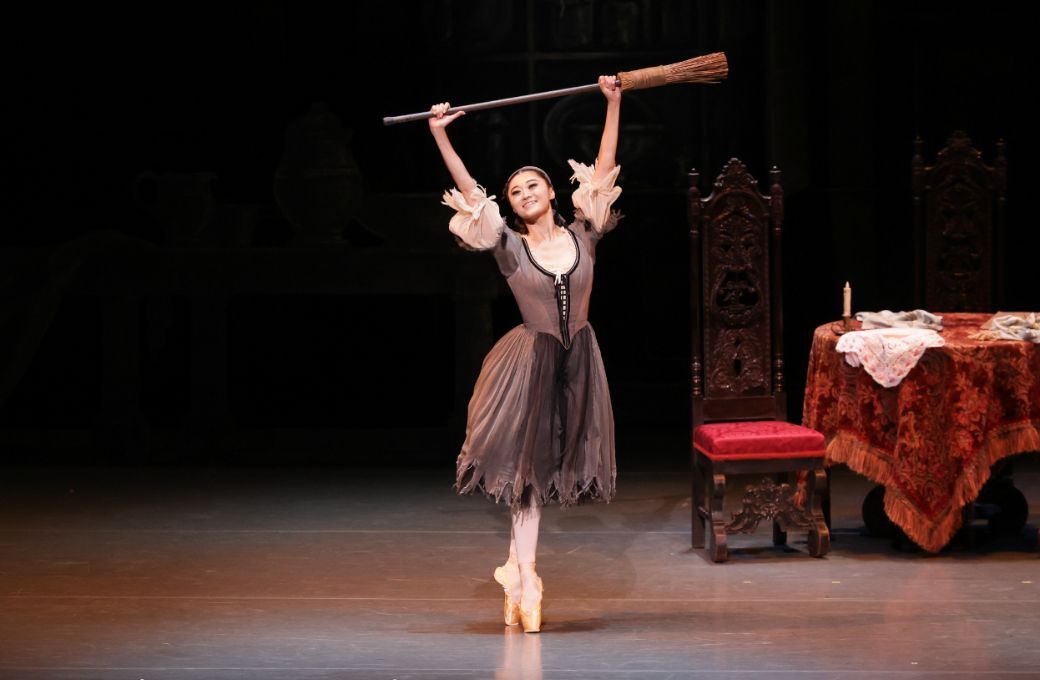National Ballet of Japan has revived Sir Frederick Ashton’s Cinderella. It has been an audience favorite since entering the company’s repertoire in 1999 and has been revived several times, the last time in 2022.

In this revival, Artistic Director Miyako Yoshida made some updates and tweaks to match the values of today along with stagers Malin Thoors and Wendy Ellis Somes. The Stepsisters who are played by male dancers are no longer ugly, nor are they bullies. The Fairy Godmother in disguise is no longer a crooked beggar but a lady who clearly shows her face which seems to attract attention.
At this performance, Yuri Kimura starred alongside Shogo Hayami – it was the first time the two have been paired together. An expressive ballerina, Kimura gave Cinderella a heart of gold and bright, positive attitude that won’t give way to adversity. Up until this point, she excelled as an adagio dancer, but in this she showed much progress as an allegro ballerina, her fast footwork and clean crisp turns worked well in her solos. Notably her dance with the broom in the first act was full of character. After transforming into the princess in the second act, the accelerating turns in her variation displayed her emotions in a beautiful way. She sparkled! With a little more focus on musicality, she will be even better.
The prince here has not so much of a character, but we could see Hayami as the prince falling in love at first sight when Cinderella graciously descends the stairs and looks over to him. Hayami is one of the most technically virtuosic dancers in the company, his soaring leaps, clean landings and reliable partnering were dashing and their pas de deux were blissfully gentle.
There were many debuts among the supporting roles as there have been some changes within the generations over the last three years. The Stepsisters who are the characters that move the story on, were amusingly played by Hiroyuki Uka (role debut) and Fukunobu Koshiba. Unfortunately Koshiba was injured in the first act and was replaced by Satoshi Nakamura, which turned out to be his unexpected role debut. He was hilarious as the big, bossy elder sister, saving the performance.
Ashton’s choreography is challenging, especially in the Seasons’ Fairy variations and here three of the four soloists were role debuts. They all rose to the challenge well, but the most experienced dancer, Spring Fairy Aoi Hirose, performed the fast, light and airy steps with ease. Suzu Yamamoto as the Fairy Godmother is a young soloist but her secure, precise footwork, floating leaps and radiant warmth, ruling the stage, showed her potential and star quality. The company is famed for their unified corps de ballet which was praised in their performances of Giselle at the Royal Opera House in London this summer. However, the intricacy of the Ashton choreography within the Stars dance was quite something and having many new dancers in the company, it was clear they had worked really hard to make the Stars shine and shimmer like those of three years ago.
The company’s current production, designed by David Walker, was first seen at the Royal Opera House in 1987 and brought to Japan in 1999, so it has been used for almost 40 years and shows some signs of wear. But the original, authentic designs do not seem to age, the modest and refined set, the pale blue tutus for the Stars and bright pastel colors for the Seasons’ Fairies, magenta colors for the Mazurka give a warm touch with the glittery Cinderella coach standing out.
This Cinderella’s somewhat modest epilogue always ignites a warm light in our hearts with a touch of fairy magic, telling us that good things happen to good people in the end. Misato Tomita, the house conductor, knows the company dancers well and the Prokofiev score played by Tokyo Philharmonic Orchestra added more sparkle to this already magical stage.


